Discrete Element Modeling of the Effect of Hydrate Distribution Heterogeneity on the Mechanical Behavior of Cemented Hydrate-Bearing Sediments
Abstract
1. Introduction
2. DEM Modeling of Cemented Hydrate-Bearing Sediments
2.1. Model Setup
2.2. Contact Models for Hydrate-Bearing Sediments
2.3. Relationship between Hydrate Saturation and Parallel Bond Parameters
3. Numerical Simulation Results
3.1. Effect of the Macroscopic Heterogeneity of Hydrates
3.1.1. Transversely Heterogeneous Hydrate Distributions
3.1.2. Longitudinally Heterogeneous Hydrate Distributions
3.2. Effect of Microscopic Heterogeneity of Hydrates
4. Discussion
4.1. Shear Strength and Secant Modulus
4.2. Deformation Characteristics
4.3. Bond Breakage Evolution
5. Conclusions
- The parallel bond contact model is applied to describe the cementing effect induced by hydrates considering the hydrate saturation at the pore-scale level. The relationship between the hydrate saturation of a sediment pore and the contact bond parameters surrounding the pore is determined based on experimental data. The results demonstrate that this method can reasonably capture the mechanical behavior of HBSs with homogeneous and heterogeneous hydrate distributions.
- Both macroscopic and microscopic hydrate distribution heterogeneity can influence the shear strength and secant modulus of HBSs. The shear strength is promoted for both macroscopically and microscopically heterogeneous HBSs. Macroscopic hydrate distribution heterogeneity can lead to HBSs with a higher shear strength than microscopic hydrate distribution heterogeneity. The secant modulus of longitudinally heterogeneous HBSs is significantly enhanced, while that of transversely heterogeneous HBSs is reduced. The secant modulus of microscopically heterogeneous HBSs first increases and then decreases with increasing pore hydrate saturation.
- The deformation behavior of HBSs depends on hydrate distribution heterogeneity. For transversely heterogeneous HBSs, pure sediments undergo major deformation for one hydrate layer; however, hydrate layers can be broken when hydrates are distributed in multiple layers. The hydrate layers are broken for all cases of longitudinally heterogeneous HBSs. Microscopically heterogeneous HBSs show similar deformation behavior with one remarkable shear band.
- In future work, other influencing factors, such as sediment type, temperature, and capillary pressure, will be incorporated into the DEM model. Furthermore, the mechanical responses of heterogeneous hydrate reservoirs during exploitation can also be investigated.
Author Contributions
Funding
Institutional Review Board Statement
Informed Consent Statement
Data Availability Statement
Conflicts of Interest
References
- Chong, Z.R.; Yang, S.H.B.; Babu, P.; Linga, P.; Li, X.-S. Review of natural gas hydrates as an energy resource: Prospects and challenges. Appl. Energy 2016, 162, 1633–1652. [Google Scholar] [CrossRef]
- Hassanpouryouzband, A.; Joonaki, E.; Farahani, M.V.; Takeya, S.; Ruppel, C.; Yang, J.; English, N.J.; Schicks, J.M.; Edlmann, K.; Mehrabian, H. Gas hydrates in sustainable chemistry. Chem. Soc. Rev. 2020, 49, 5225–5309. [Google Scholar] [CrossRef] [PubMed]
- Boswell, R.; Collett, T.S. Current perspectives on gas hydrate resources. Energy Environ. Sci. 2011, 4, 1206–1215. [Google Scholar] [CrossRef]
- Walsh, M.R.; Hancock, S.H.; Wilson, S.J.; Patil, S.L.; Moridis, G.J.; Boswell, R.; Collett, T.S.; Koh, C.A.; Sloan, E.D. Preliminary report on the commercial viability of gas production from natural gas hydrates. Energy Econ. 2009, 31, 815–823. [Google Scholar] [CrossRef]
- Makogon, Y.F. Natural gas hydrates—A promising source of energy. J. Nat. Gas Sci. Eng. 2010, 2, 49–59. [Google Scholar] [CrossRef]
- Bazaluk, O.; Sai, K.; Lozynskyi, V.; Petlovanyi, M.; Saik, P. Research into Dissociation Zones of Gas Hydrate Deposits with a Heterogeneous Structure in the Black Sea. Energies 2021, 14, 1345. [Google Scholar] [CrossRef]
- Farahani, M.V.; Hassanpouryouzband, A.; Yang, J.; Tohidi, B. Development of a coupled geophysical–geothermal scheme for quantification of hydrates in gas hydrate-bearing permafrost sediments. Phys. Chem. Chem. Phys. 2021, 23, 24249–24264. [Google Scholar] [CrossRef]
- Sloan, E.D.; Koh, C.A. Clathrate Hydrates of Natural Gases, 3rd ed.; CRC Press: Boca Raton, FL, USA, 2007. [Google Scholar]
- Kurihara, M.; Sato, A.; Funatsu, K.; Ouchi, H.; Yamamoto, K.; Numasawa, M.; Ebinuma, T.; Narita, H.; Masuda, Y.; Dallimore, S.R. Analysis of production data for 2007/2008 Mallik gas hydrate production tests in Canada. In Proceedings of the International Oil and Gas Conference and Exhibition in China, Beijing, China, 8–10 June 2010. [Google Scholar]
- Konno, Y.; Fujii, T.; Sato, A.; Akamine, K.; Naiki, M.; Masuda, Y.; Yamamoto, K.; Nagao, J. Key findings of the world’s first offshore methane hydrate production test off the coast of Japan: Toward future commercial production. Energy Fuels 2017, 31, 2607–2616. [Google Scholar] [CrossRef]
- Chen, L.; Feng, Y.; Okajima, J.; Komiya, A.; Maruyama, S. Production behavior and numerical analysis for 2017 methane hydrate extraction test of Shenhu, South China Sea. J. Nat. Gas Sci. Eng. 2018, 53, 55–66. [Google Scholar] [CrossRef]
- Ye, J.-L.; Qin, X.-W.; Xie, W.-W.; Lu, H.-L.; Ma, B.-J.; Qiu, H.-J.; Liang, J.-Q.; Lu, J.-A.; Kuang, Z.-G.; Lu, C.; et al. The second natural gas hydrate production test in the South China Sea. China Geol. 2020, 3, 197–209. [Google Scholar] [CrossRef]
- Klymenko, V.; Ovetskyi, S.; Martynenko, V.; Vytiaz, O.; Uhrynovskyi, A. An alternative method of methane production from deposits of subaquatic gas hydrates. Min. Miner. Depos. 2022, 16, 11–17. [Google Scholar] [CrossRef]
- Wang, Z.; Zhang, Y.; Peng, Z.; Shan, Z.; Sun, B.; Sun, J. Recent Advances in Methods of Gas Recovery from Hydrate-Bearing Sediments: A Review. Energy Fuels 2022, 36, 5550–5593. [Google Scholar] [CrossRef]
- Kayen, R.E.; Lee, H.J. Pleistocene slope instability of gas hydrate-laden sediment on the Beaufort Sea margin. Mar. Georesour. Geotechnol. 1991, 10, 125–141. [Google Scholar] [CrossRef]
- Nixon, M.F.; Grozic, J.L. Submarine slope failure due to gas hydrate dissociation: A preliminary quantification. Can. Geotech. J. 2007, 44, 314–325. [Google Scholar] [CrossRef]
- Zhao, Y.; Kong, L.; Liu, L.; Liu, J. Influence of hydrate exploitation on stability of submarine slopes. Nat. Hazards 2022, 113, 719–743. [Google Scholar] [CrossRef]
- Jiang, M.; Sun, C.; Crosta, G.B.; Zhang, W. A study of submarine steep slope failures triggered by thermal dissociation of methane hydrates using a coupled CFD-DEM approach. Eng. Geol. 2015, 190, 1–16. [Google Scholar] [CrossRef]
- Ye, J.-L.; Qin, X.-W.; Qiu, H.-J.; Liang, Q.-Y.; Dong, Y.-F.; Wei, J.-G.; Lu, H.-L.; Lu, J.-A.; Shi, Y.-H.; Zhong, C. Preliminary results of environmental monitoring of the natural gas hydrate production test in the South China Sea. China Geol. 2018, 1, 202–209. [Google Scholar] [CrossRef]
- Sun, J.; Ning, F.; Lei, H.; Gai, X.; Sánchez, M.; Lu, J.; Li, Y.; Liu, L.; Liu, C.; Wu, N.; et al. Wellbore stability analysis during drilling through marine gas hydrate-bearing sediments in Shenhu area: A case study. J. Pet. Sci. Eng. 2018, 170, 345–367. [Google Scholar] [CrossRef]
- Ruppel, C.D.; Kessler, J.D. The interaction of climate change and methane hydrates. Rev. Geophys. 2017, 55, 126–168. [Google Scholar] [CrossRef]
- Hyodo, M.; Li, Y.; Yoneda, J.; Nakata, Y.; Yoshimoto, N.; Nishimura, A.; Song, Y. Mechanical behavior of gas-saturated methane hydrate-bearing sediments. J. Geophys. Res. Solid Earth 2013, 118, 5185–5194. [Google Scholar] [CrossRef]
- Kajiyama, S.; Hyodo, M.; Nakata, Y.; Yoshimoto, N.; Wu, Y.; Kato, A. Shear behaviour of methane hydrate bearing sand with various particle characteristics and fines. Soils Found. 2017, 57, 176–193. [Google Scholar] [CrossRef]
- Ding, Y.; Qian, A.; Lu, H.; Li, Y.; Zhang, Y. DEM investigation of the effect of hydrate morphology on the mechanical properties of hydrate-bearing sands. Comput. Geotech. 2022, 143, 104603. [Google Scholar] [CrossRef]
- Masui, A.; Haneda, H.; Ogata, Y.; Aoki, K. Effects of methane hydrate formation on shear strength of synthetic methane hydrate sediments. In Proceedings of the The Fifteenth International Offshore and Polar Engineering Conference, Seoul, Korea, 19–24 June 2005; pp. 364–369. [Google Scholar]
- Miyazaki, K.; Masui, A.; Sakamoto, Y.; Aoki, K.; Tenma, N.; Yamaguchi, T. Triaxial compressive properties of artificial methane-hydrate-bearing sediment. J. Geophys. Res. Solid Earth 2011, 116, 8049. [Google Scholar] [CrossRef]
- Ke, W.; Svartaas, T.M.; Chen, D. A review of gas hydrate nucleation theories and growth models. J. Nat. Gas Sci. Eng. 2019, 61, 169–196. [Google Scholar] [CrossRef]
- Gambelli, A.M.; Rossi, F. Thermodynamic and kinetic characterization of methane hydrate ‘nucleation, growth and dissociation processes, according to the labile Cluster theory. Chem. Eng. J. 2021, 425, 130706. [Google Scholar] [CrossRef]
- Radhakrishnan, R.; Trout, B.L. A new approach for studying nucleation phenomena using molecular simulations: Application to CO2 hydrate clathrates. J. Chem. Phys. 2002, 117, 1786–1796. [Google Scholar] [CrossRef]
- Jacobson, L.C.; Hujo, W.; Molinero, V. Amorphous precursors in the nucleation of clathrate hydrates. J. Am. Chem. Soc. 2010, 132, 11806–11811. [Google Scholar] [CrossRef]
- Kvamme, B. A new theory for the kinetics of hydrate formation. In Proceedings of the NGH 96: 2nd International Conference on Natural Gaz Hydrates, Toulouse, France, 2–6 June 1996; pp. 139–146. [Google Scholar]
- Sloan, E., Jr.; Fleyfel, F. A molecular mechanism for gas hydrate nucleation from ice. AIChE J. 1991, 37, 1281–1292. [Google Scholar] [CrossRef]
- Liu, W.; Pan, D.; Shen, S.; You, Z.; Zhao, Y.; Sun, X. Experimental Study on Mechanical Properties of Hydrate-Bearing Sand: The Influence of Sand-Water Mixing Methods. Energies 2021, 14, 2554. [Google Scholar] [CrossRef]
- Ren, X.; Guo, Z.; Ning, F.; Ma, S. Permeability of hydrate-bearing sediments. Earth Sci. Rev. 2020, 202, 103100. [Google Scholar] [CrossRef]
- Wu, P.; Li, Y.; Liu, W.; Sun, X.; Kong, X.; Song, Y. Cementation failure behavior of consolidated gas hydrate-bearing sand. J. Geophys. Res. Solid Earth 2020, 125, e2019JB018623. [Google Scholar] [CrossRef]
- Lei, L.; Seol, Y.; Jarvis, K. Pore-scale visualization of methane hydrate-bearing sediments with micro-CT. Geophys. Res. Lett. 2018, 45, 5417–5426. [Google Scholar] [CrossRef]
- Brugada, J.; Cheng, Y.; Soga, K.; Santamarina, J. Discrete element modelling of geomechanical behaviour of methane hydrate soils with pore-filling hydrate distribution. Granul. Matter 2010, 12, 517–525. [Google Scholar] [CrossRef]
- Qian, A.; Ding, Y.; Lu, H. Discrete element modeling of the effect of particle size distribution on direct shear behavior of hydrate-bearing sediments. In Proceedings of the IOP Conference Series: Earth and Environmental Science, Beijing, China, 16 December 2021; p. 032073. [Google Scholar]
- Yu, Y.; Cheng, Y.P.; Xu, X.; Soga, K. Discrete element modelling of methane hydrate soil sediments using elongated soil particles. Comput. Geotech. 2016, 80, 397–409. [Google Scholar] [CrossRef]
- Zhang, H.; Bi, J.; Luo, X. Oedometer test of natural gas hydrate-bearing sands: Particle-scale simulation. J. Nat. Gas Sci. Eng. 2020, 84, 103631. [Google Scholar] [CrossRef]
- Yu, Y.; Xu, X.; Cheng, Y.P.; Soga, K. Study on small-strain behaviours of methane hydrate sandy sediments using discrete element method. In Proceedings of the 7th International Conference on Micromechanics of Granular Media, Sydney, Australia, 8–12 July 2013; pp. 555–558. [Google Scholar]
- Jiang, M.; Shen, Z.; Wu, D. CFD-DEM simulation of submarine landslide triggered by seismic loading in methane hydrate rich zone. Landslides 2018, 15, 2227–2241. [Google Scholar] [CrossRef]
- Yao, Y.; Guo, Z.; Zeng, J.; Li, D.; Lu, J.; Liang, D.; Jiang, M. Discrete Element Analysis of Hydraulic Fracturing of Methane Hydrate-Bearing Sediments. Energy Fuels 2021, 35, 6644–6657. [Google Scholar] [CrossRef]
- Liu, J.-W.; Li, X.-S.; Kou, X.; Wang, Y.; Li, L.-J. Analysis of Hydrate Heterogeneous Distribution Effects on Mechanical Characteristics of Hydrate-Bearing Sediments. Energy Fuels 2021, 35, 4914–4924. [Google Scholar] [CrossRef]
- Ding, Y.; Qian, A.; Lu, H. Influences of hydrate morphology and hydrate distribution heterogeneity on the mechanical properties of hydrate-bearing sediments using the discrete element method. Geomech. Geophys. Geo Energy Geo Resour. 2022, 8, 106. [Google Scholar] [CrossRef]
- Itasca Consulting Group. Particle Flow Code (PFC): User’s Manual, Version 5.0.; Itasca Consulting Group: Minneapolis, MT, USA, 2015. [Google Scholar]
- Hyodo, M.; Yoneda, J.; Yoshimoto, N.; Nakata, Y. Mechanical and dissociation properties of methane hydrate-bearing sand in deep seabed. Soils Found. 2013, 53, 299–314. [Google Scholar] [CrossRef]
- Wu, K.; Liu, S.; Sun, W.; Rémond, S. DEM study of the shear behavior and formation of shear band in biaxial test. Adv. Powder Technol. 2020, 31, 1431–1440. [Google Scholar] [CrossRef]
- Zhu, H.-X.; Yin, Z.-Y.; Zhang, Q. A novel coupled FDM-DEM modelling method for flexible membrane boundary in laboratory tests. Int. J. Numer. Anal. Methods Geomech. 2020, 44, 389–404. [Google Scholar] [CrossRef]
- de Bono, J.; McDowell, G.; Wanatowski, D. Discrete element modelling of a flexible membrane for triaxial testing of granular material at high pressures. Géotech. Lett. 2012, 2, 199–203. [Google Scholar] [CrossRef]
- Wu, M.; Huang, R.; Wang, J. DEM simulations of cemented sands with a statistical representation of micro-bond parameters. Powder Technol. 2021, 379, 96–107. [Google Scholar] [CrossRef]
- Ding, Y.; Qian, A.; Lu, H. Three-dimensional discrete element modeling of the shear behavior of cemented hydrate-bearing sands. J. Nat. Gas Sci. Eng. 2022, 101, 104526. [Google Scholar] [CrossRef]
- Jiang, M.; Chen, H.; Tapias, M.; Arroyo, M.; Fang, R. Study of mechanical behavior and strain localization of methane hydrate bearing sediments with different saturations by a new DEM model. Comput. Geotech. 2014, 57, 122–138. [Google Scholar] [CrossRef]
- Jiang, M.; Sun, R.; Arroyo, M.; Du, W. Salinity effects on the mechanical behaviour of methane hydrate bearing sediments: A DEM investigation. Comput. Geotech. 2021, 133, 104067. [Google Scholar] [CrossRef]
- Shen, Z.; Jiang, M. DEM simulation of bonded granular material. Part II Ext. Grain Coat. Type Methane Hydrate Bear. Sand. Comput. Geotech. 2016, 75, 225–243. [Google Scholar]
- Priest, J.A.; Rees, E.V.; Clayton, C.R. Influence of gas hydrate morphology on the seismic velocities of sands. J. Geophys. Res. Solid Earth 2009, 114, B11205. [Google Scholar] [CrossRef]
- Jiang, M.; Sun, Y.; Yang, Q. A simple distinct element modeling of the mechanical behavior of methane hydrate-bearing sediments in deep seabed. Granul. Matter 2013, 15, 209–220. [Google Scholar] [CrossRef]
- Jiang, M.; Zhu, F.; Liu, F.; Utili, S. A bond contact model for methane hydrate-bearing sediments with interparticle cementation. Int. J. Numer. Anal. Methods Geomech. 2014, 38, 1823–1854. [Google Scholar] [CrossRef]
- Li, C.; Liu, C.; Hu, G.; Sun, J.; Hao, X.; Liu, L.; Meng, Q. Investigation on the multiparameter of hydrate-bearing sands using nano-focus X-ray computed tomography. J. Geophys. Res. Solid Earth 2019, 124, 2286–2296. [Google Scholar] [CrossRef]
- Kajiyama, S.; Wu, Y.; Hyodo, M.; Nakata, Y.; Nakashima, K.; Yoshimoto, N. Experimental investigation on the mechanical properties of methane hydrate-bearing sand formed with rounded particles. J. Nat. Gas Sci. Eng. 2017, 45, 96–107. [Google Scholar] [CrossRef]
- Holt, R.M.; Kjølaas, J.; Larsen, I.; Li, L.; Gotusso Pillitteri, A.; Sønstebø, E.F. Comparison between controlled laboratory experiments and discrete particle simulations of the mechanical behaviour of rock. Int. J. Rock Mech. Min. Sci. 2005, 42, 985–995. [Google Scholar] [CrossRef]
- Waite, W.F.; Santamarina, J.C.; Cortes, D.D.; Dugan, B.; Espinoza, D.N.; Germaine, J.; Jang, J.; Jung, J.; Kneafsey, T.J.; Shin, H.; et al. Physical properties of hydrate-bearing sediments. Rev. Geophys. 2009, 47, 279. [Google Scholar] [CrossRef]
- Kou, X.; Feng, J.-C.; Li, X.-S.; Wang, Y.; Chen, Z.-Y. Formation mechanism of heterogeneous hydrate-bearing sediments. Appl. Energy 2022, 326, 119931. [Google Scholar] [CrossRef]

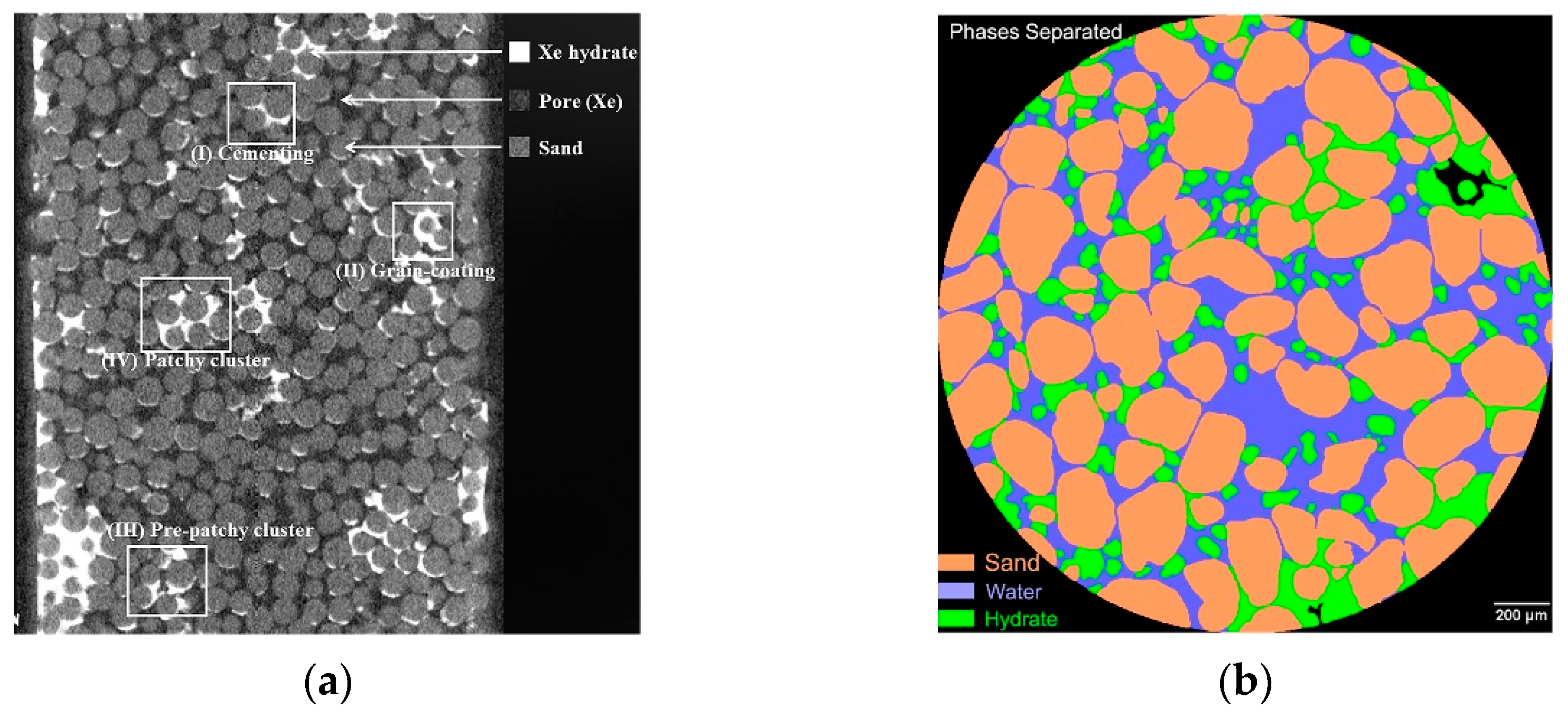
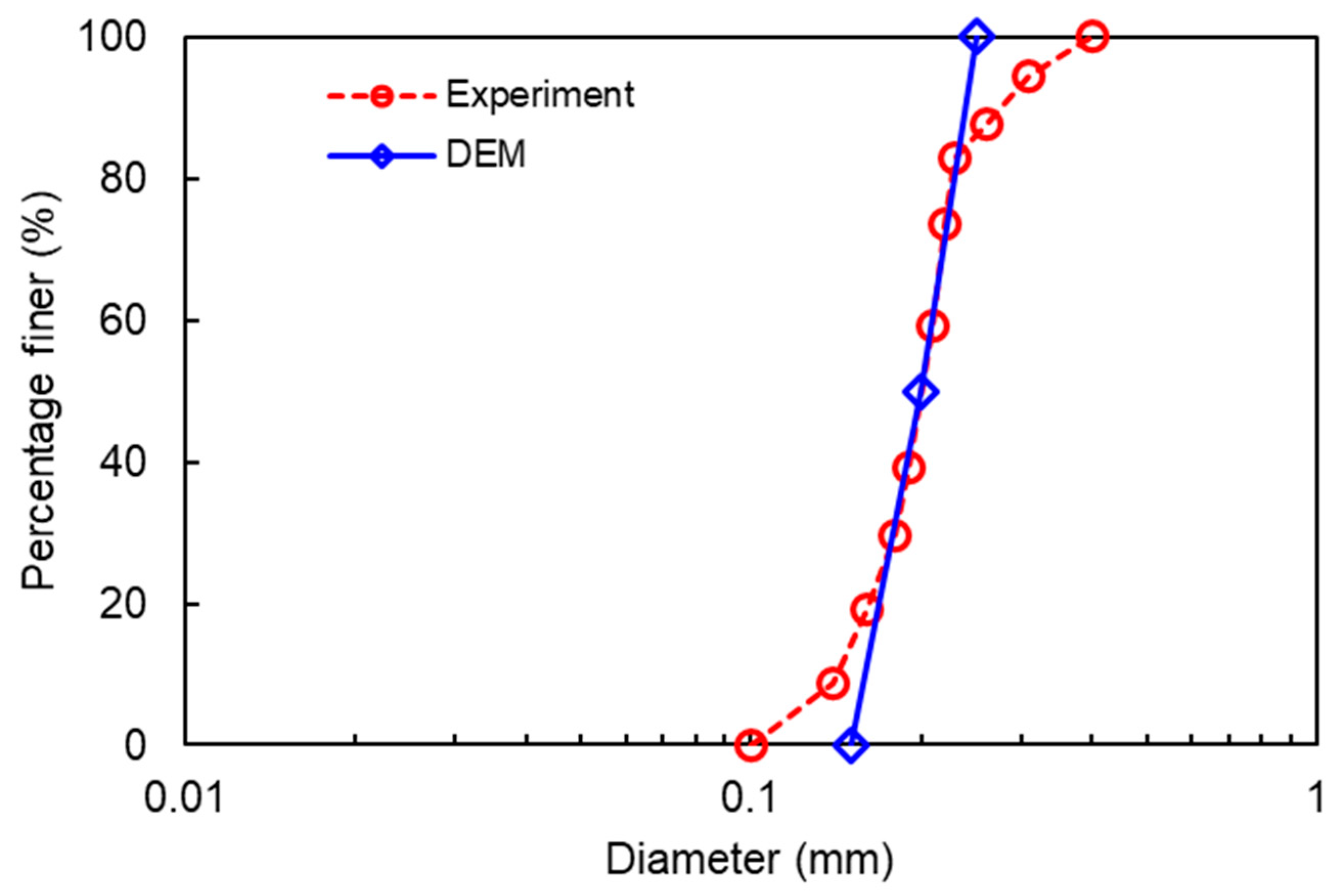
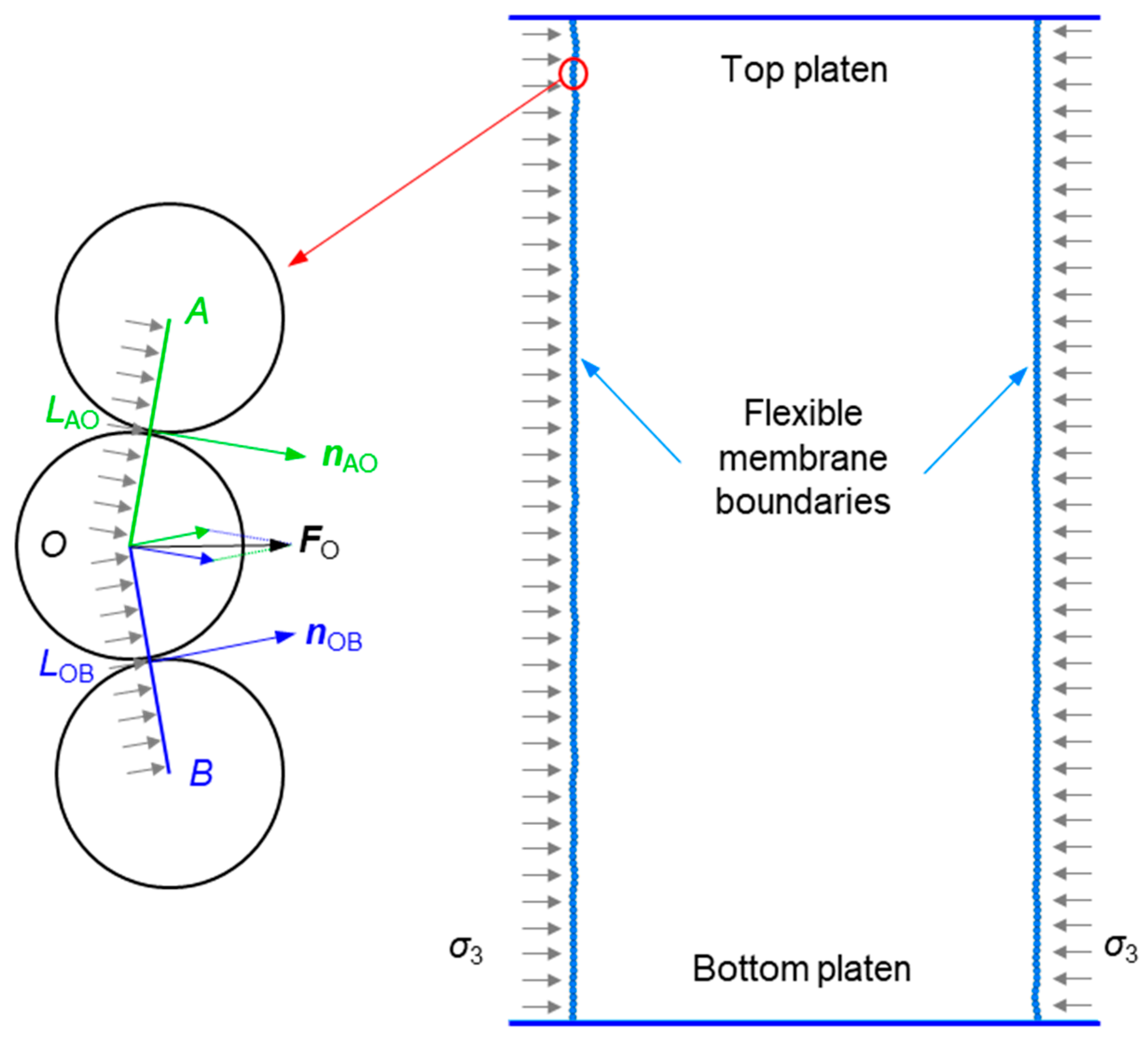



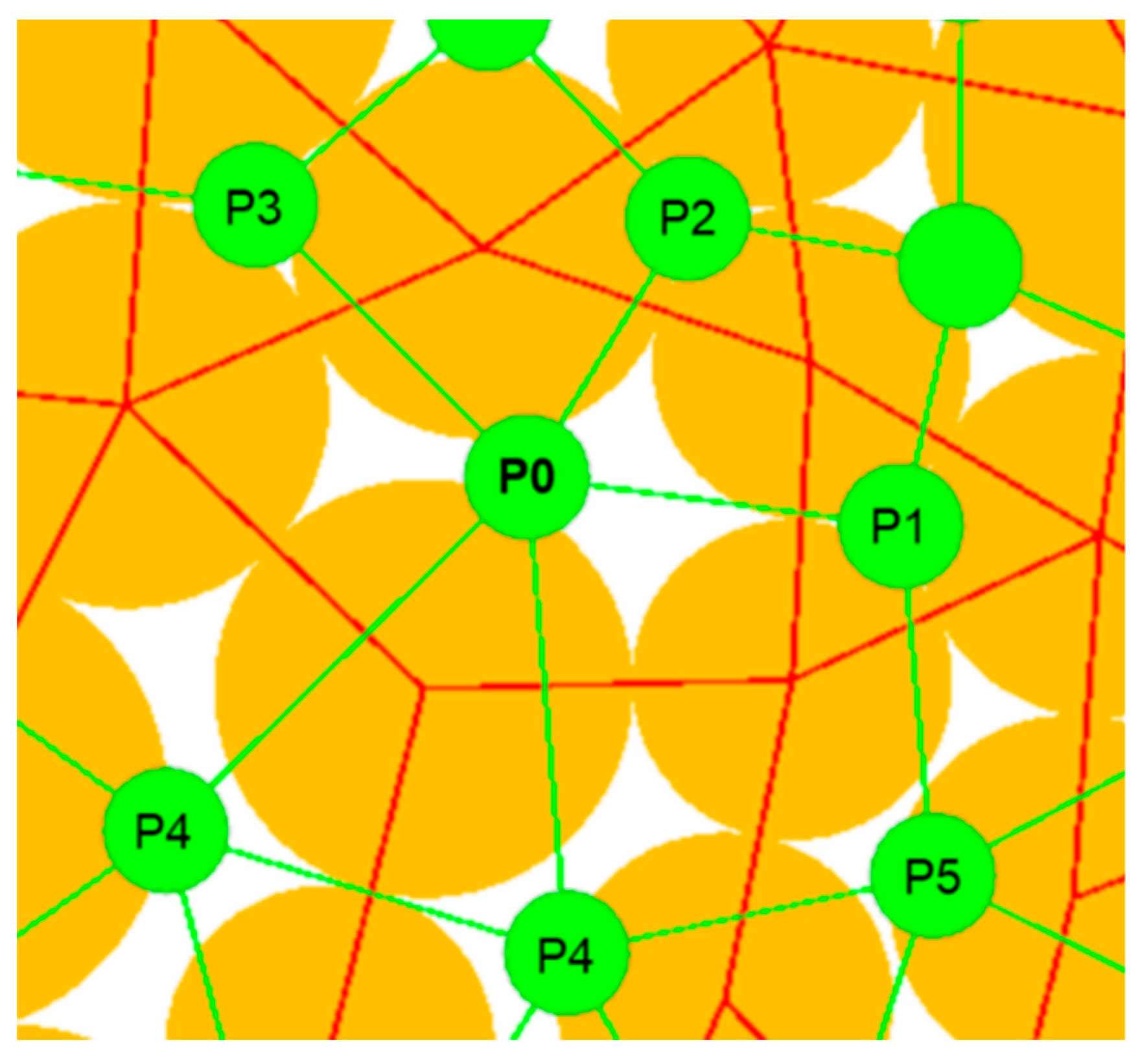

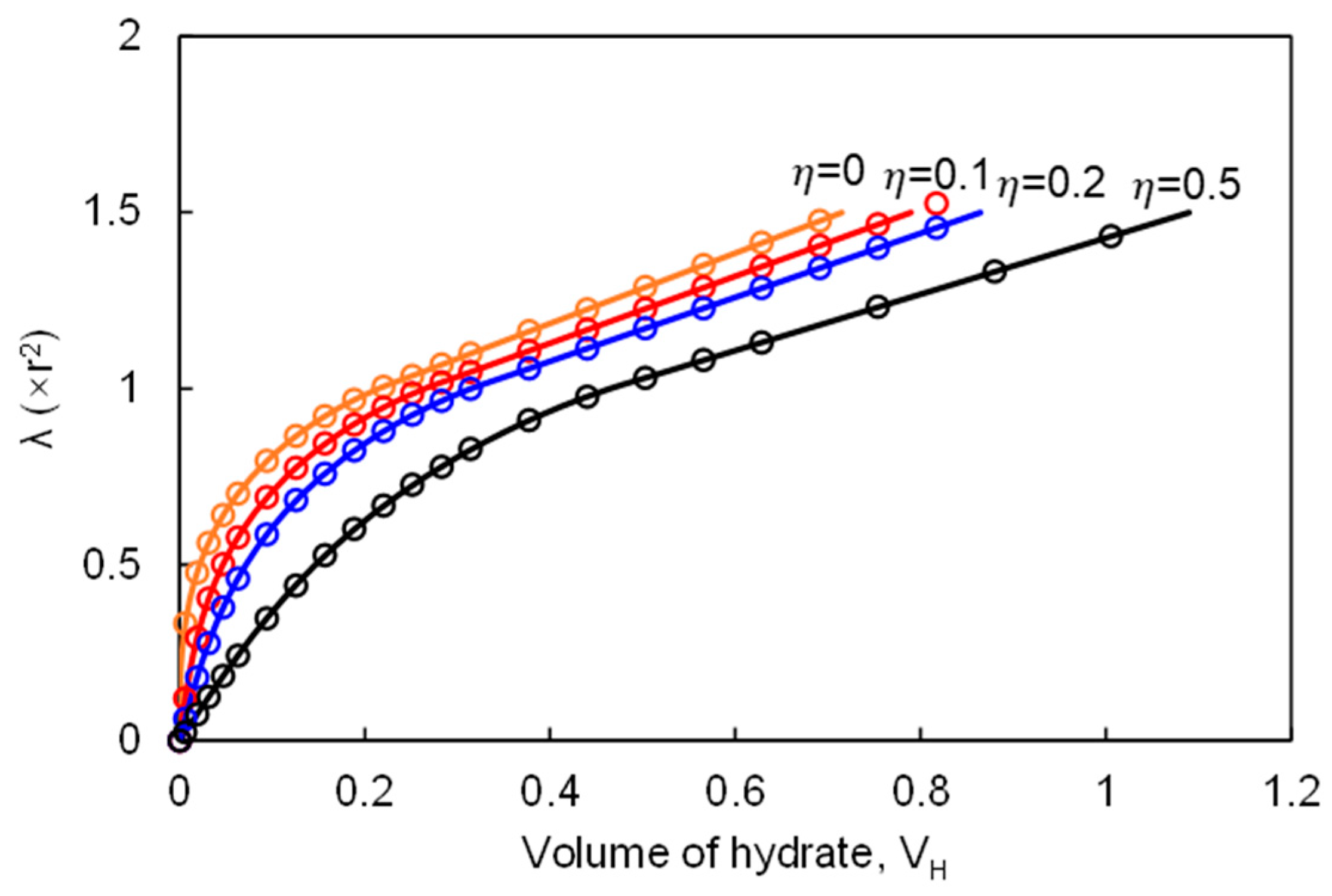
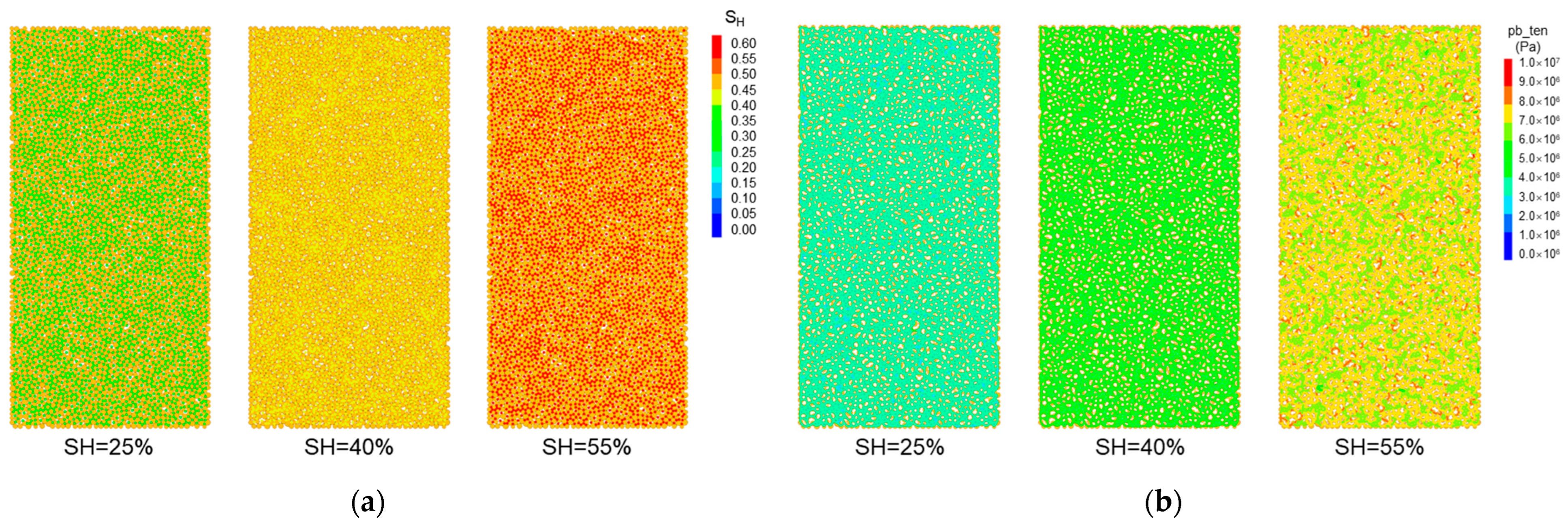

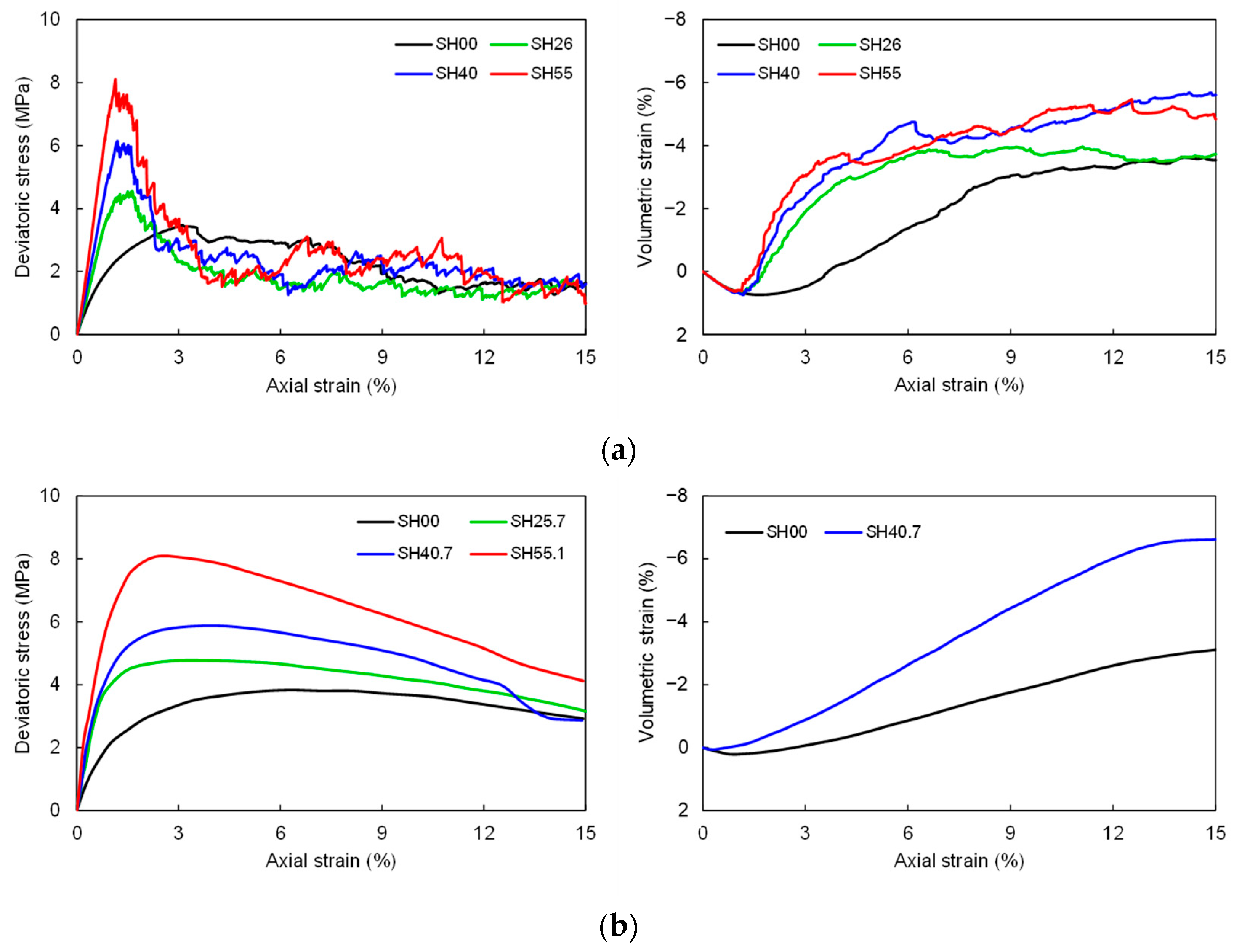
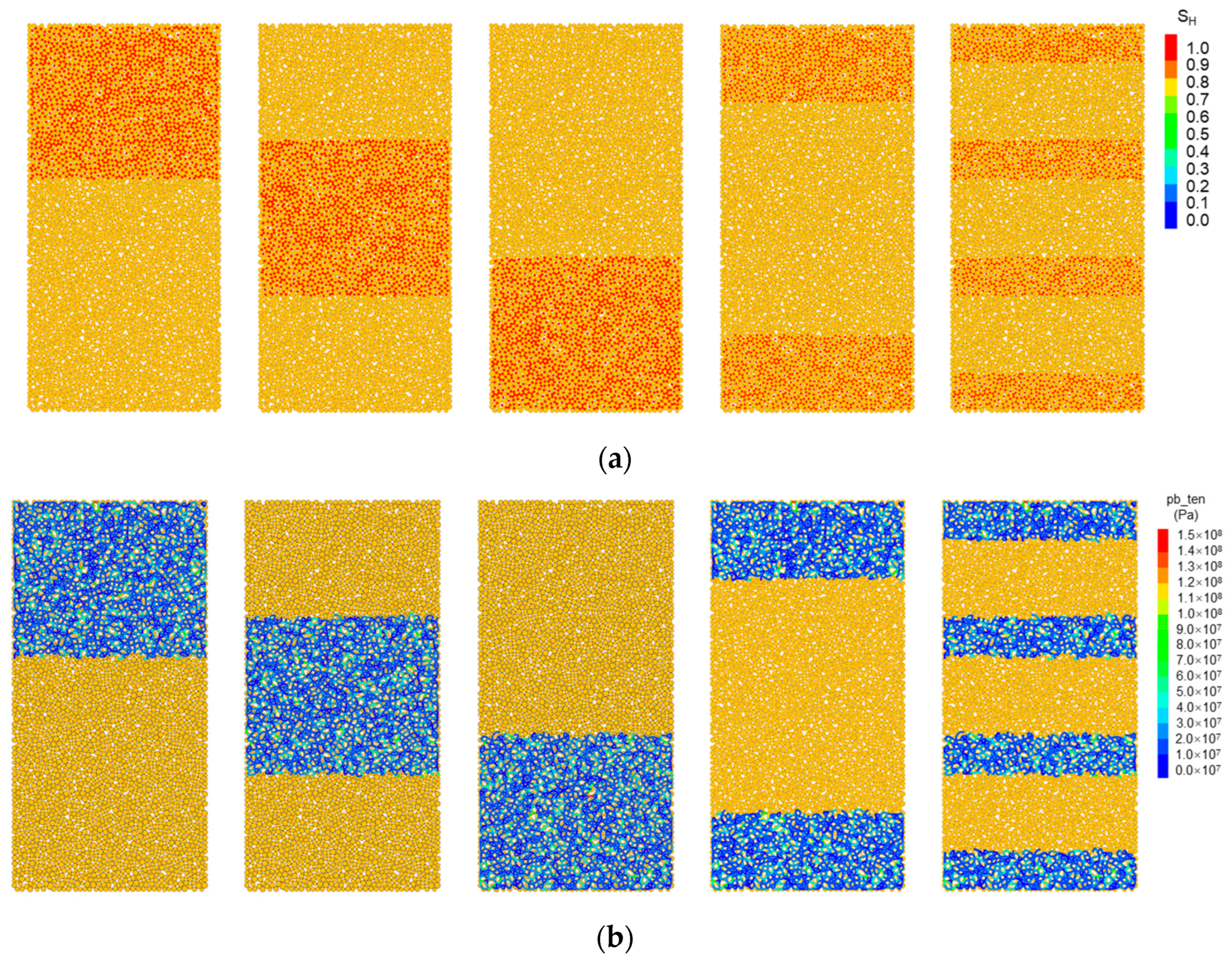
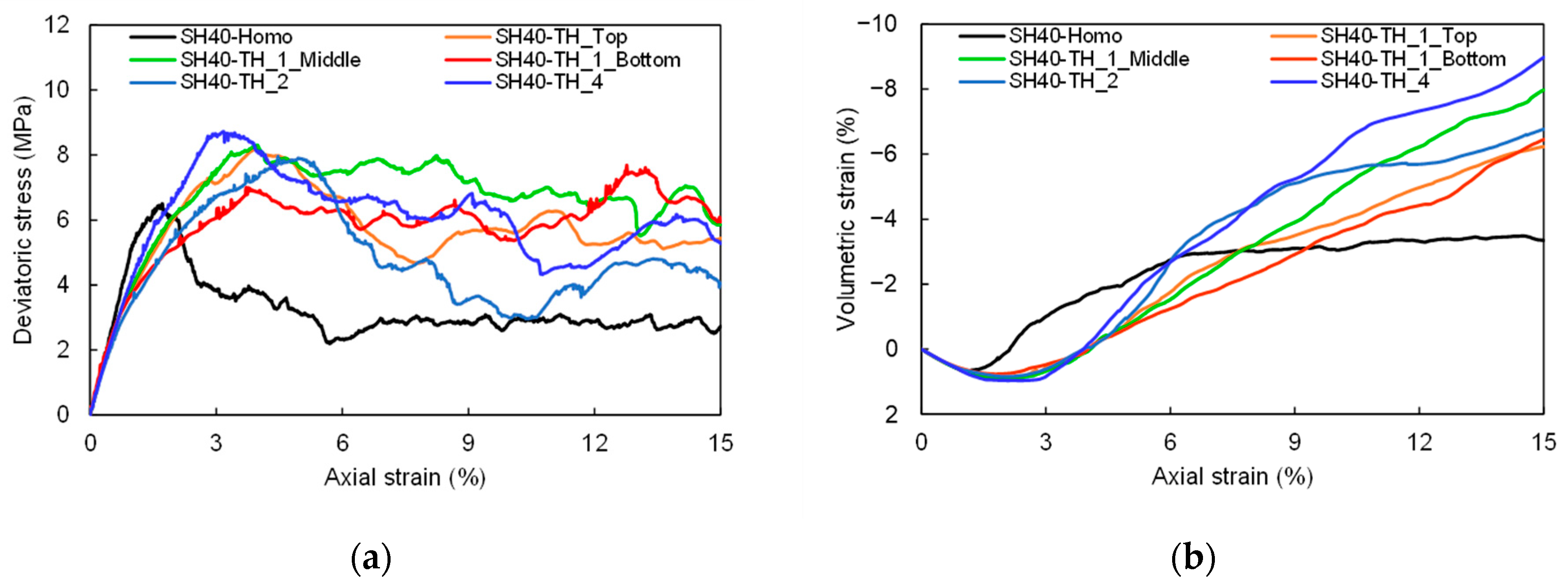
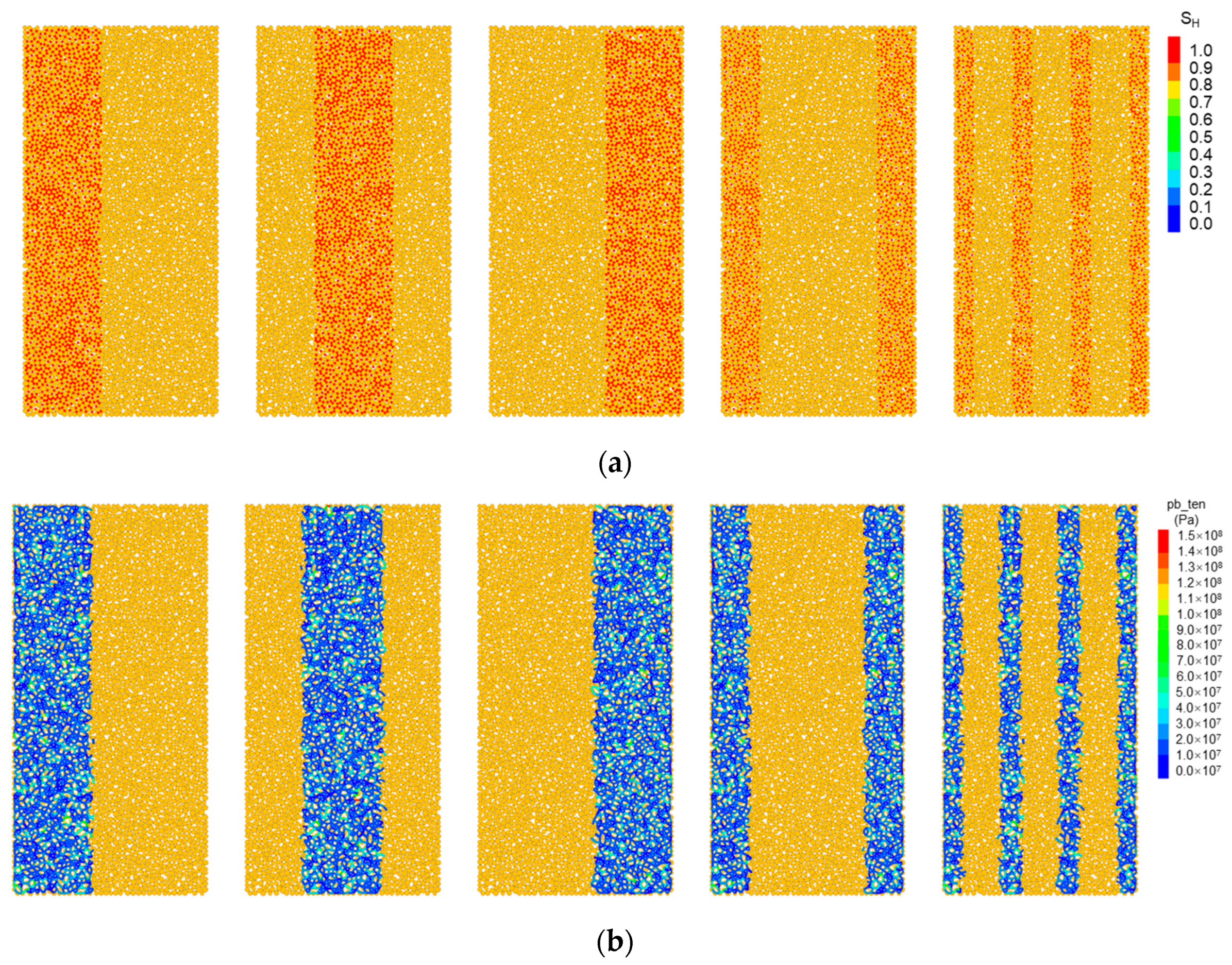


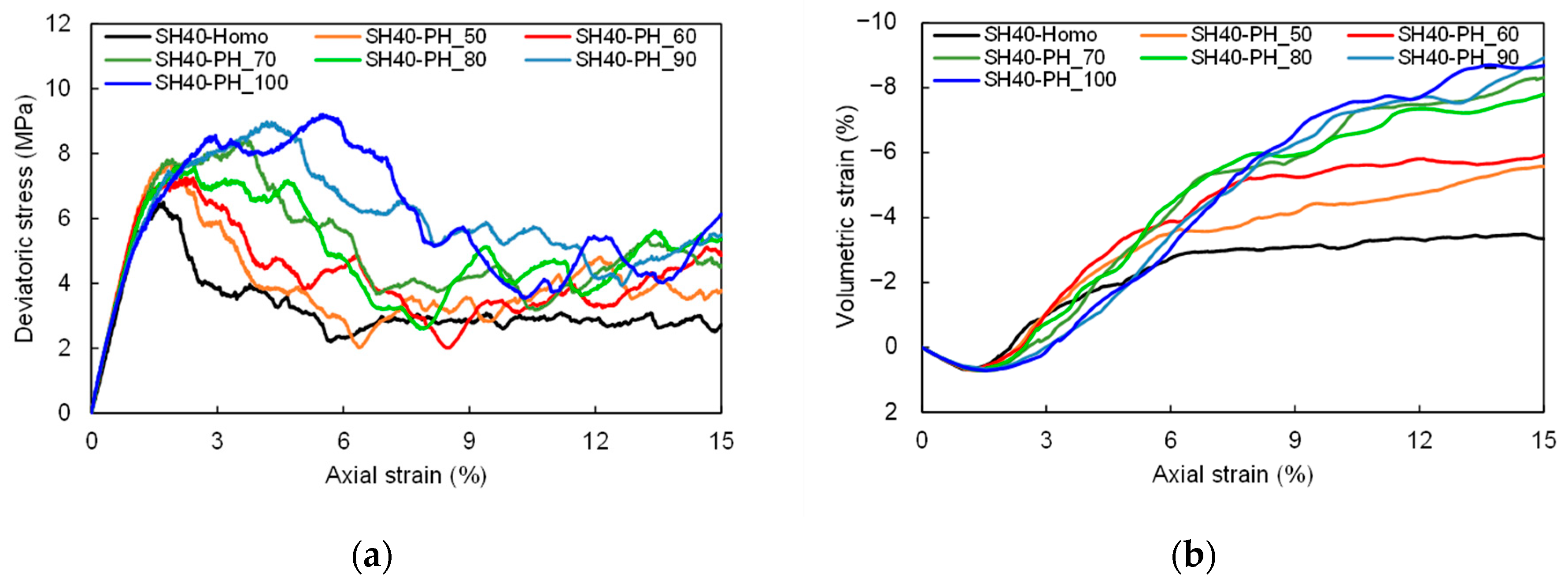

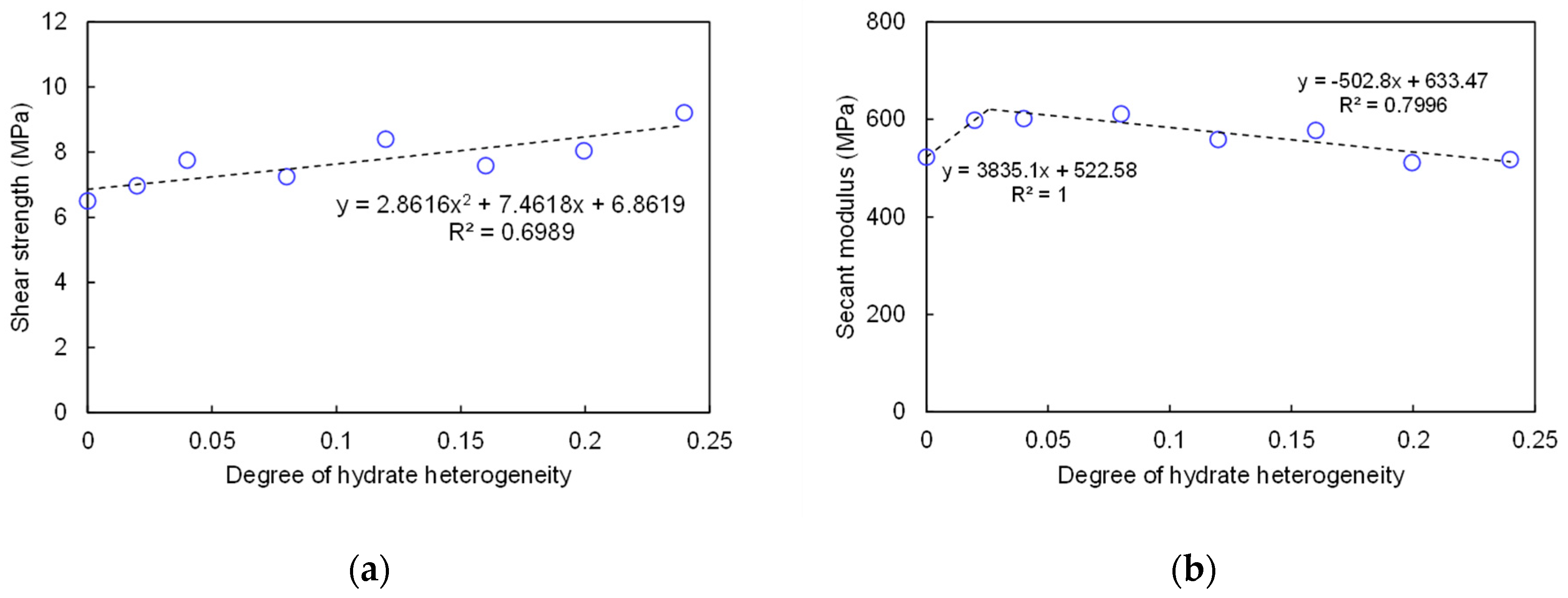


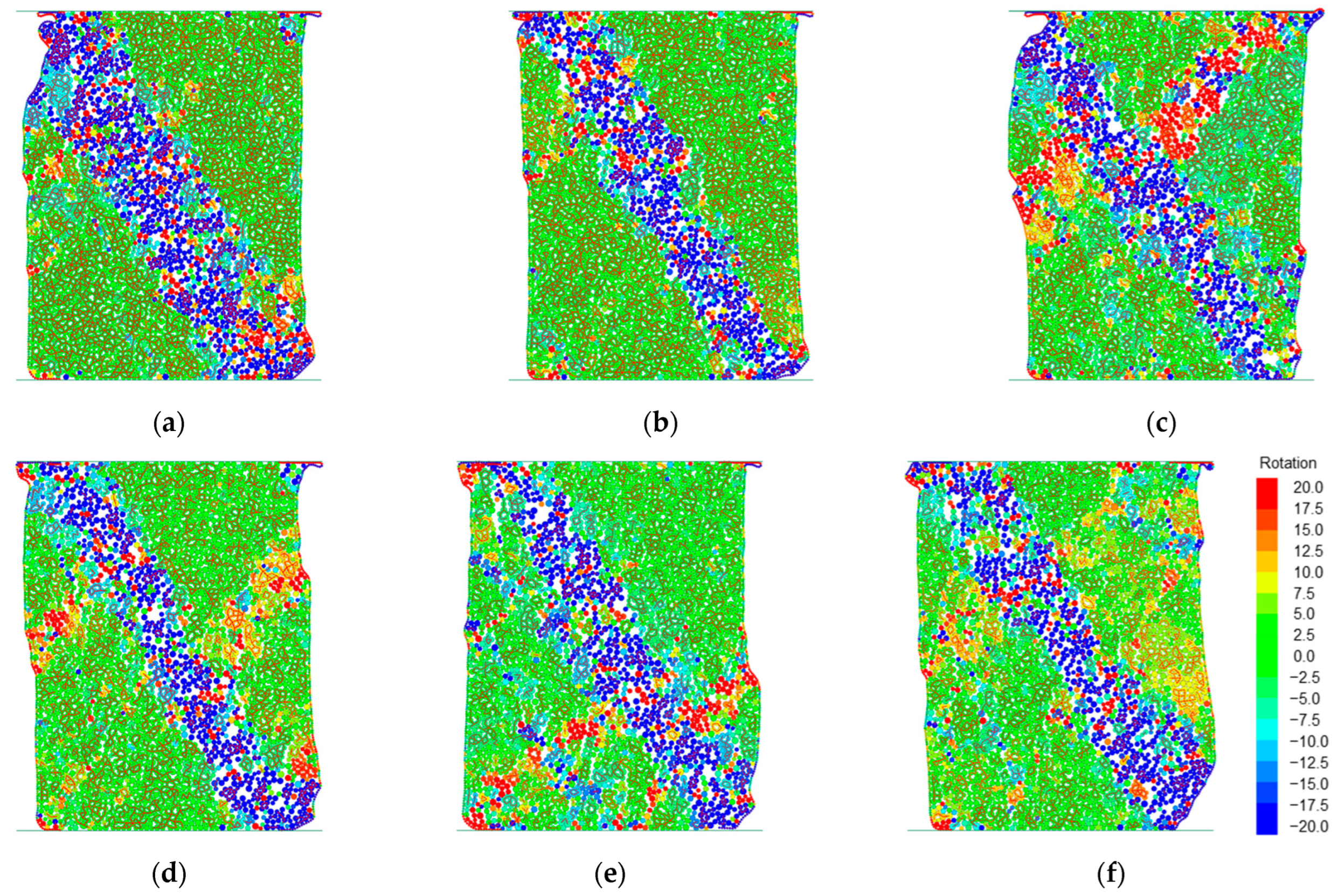

| Parameters | Host Sediments | Membrane | Unit |
|---|---|---|---|
| Sediment particle density | 2650 | 1000 | kg/m3 |
| Sediment particle radii | 0.15–0.25 | 0.004 | mm |
| Normal stiffness | 9.0 × 108 | 9.0 × 107 | N/m |
| Normal to tangential stiffness ratio | 1.5 | 1.5 | - |
| Interparticle friction of sands | 0.5 | 0.0 | - |
| Rolling resistance coefficient | 0.5 | 0.0 | - |
| Tensile strength of bonds | Calculated by Equation (10) | 1 × 10100 | MPa |
| Cohesion of bond | Calculated by Equation (10) | 1 × 10100 | MPa |
| Damping coefficient | 0.7 | 0.7 | - |
| Parallel bond normal stiffness | Calculated by Equation (9) | 9.0 × 1011 | N/m |
| Parallel bond stiffness ratio | 1.5 | 1.5 | - |
| Parallel bond radius multiplier | 1.0 | - | - |
Disclaimer/Publisher’s Note: The statements, opinions and data contained in all publications are solely those of the individual author(s) and contributor(s) and not of MDPI and/or the editor(s). MDPI and/or the editor(s) disclaim responsibility for any injury to people or property resulting from any ideas, methods, instructions or products referred to in the content. |
© 2023 by the authors. Licensee MDPI, Basel, Switzerland. This article is an open access article distributed under the terms and conditions of the Creative Commons Attribution (CC BY) license (https://creativecommons.org/licenses/by/4.0/).
Share and Cite
Wang, T.; Ding, Y.; Wang, R.; Qian, A.; Lu, H.; Zhou, B. Discrete Element Modeling of the Effect of Hydrate Distribution Heterogeneity on the Mechanical Behavior of Cemented Hydrate-Bearing Sediments. J. Mar. Sci. Eng. 2023, 11, 831. https://doi.org/10.3390/jmse11040831
Wang T, Ding Y, Wang R, Qian A, Lu H, Zhou B. Discrete Element Modeling of the Effect of Hydrate Distribution Heterogeneity on the Mechanical Behavior of Cemented Hydrate-Bearing Sediments. Journal of Marine Science and Engineering. 2023; 11(4):831. https://doi.org/10.3390/jmse11040831
Chicago/Turabian StyleWang, Tianju, Yanlu Ding, Rui Wang, Anna Qian, Hailong Lu, and Boyu Zhou. 2023. "Discrete Element Modeling of the Effect of Hydrate Distribution Heterogeneity on the Mechanical Behavior of Cemented Hydrate-Bearing Sediments" Journal of Marine Science and Engineering 11, no. 4: 831. https://doi.org/10.3390/jmse11040831
APA StyleWang, T., Ding, Y., Wang, R., Qian, A., Lu, H., & Zhou, B. (2023). Discrete Element Modeling of the Effect of Hydrate Distribution Heterogeneity on the Mechanical Behavior of Cemented Hydrate-Bearing Sediments. Journal of Marine Science and Engineering, 11(4), 831. https://doi.org/10.3390/jmse11040831







